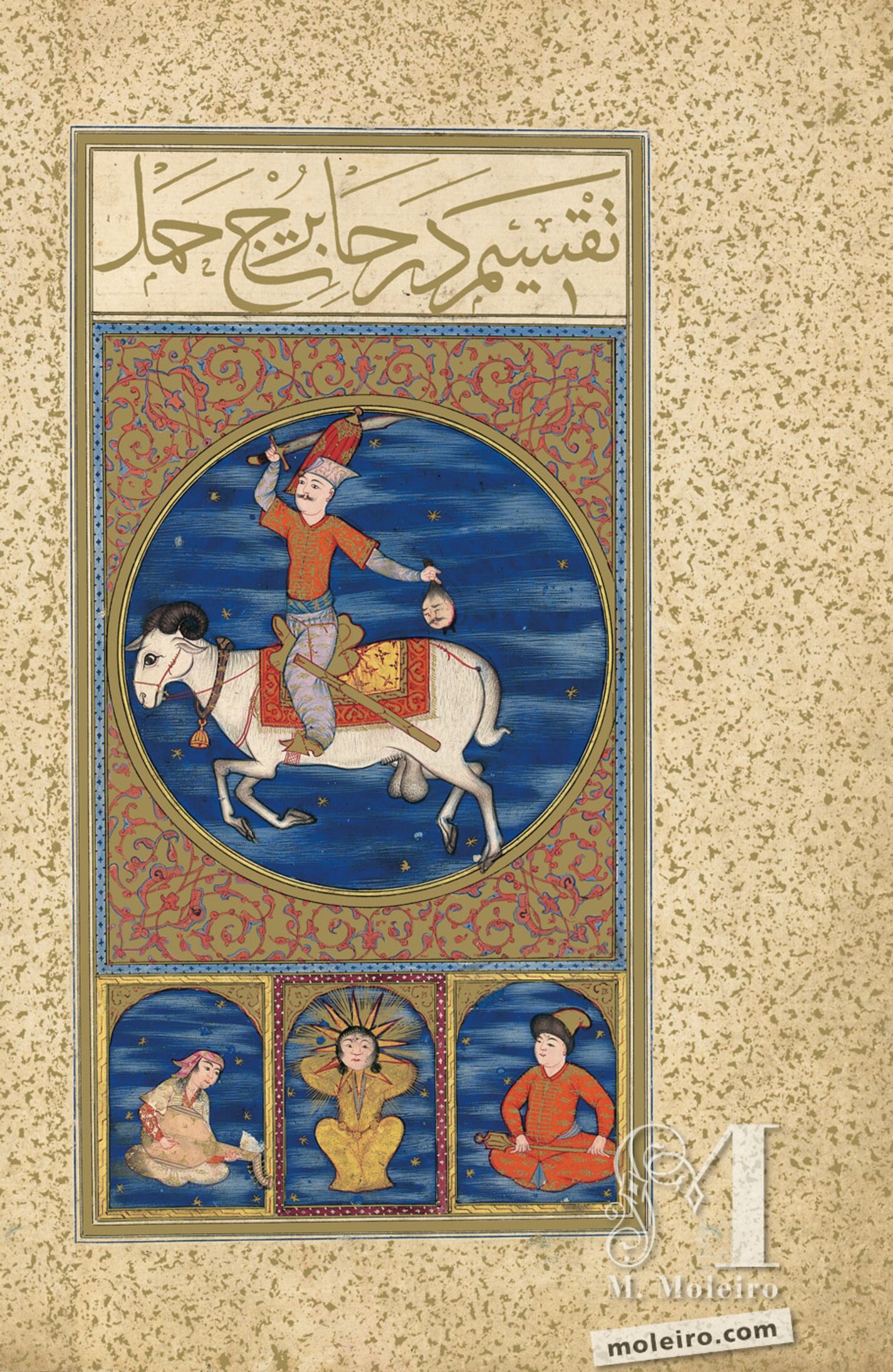Each of the twelve signs of the zodiac in Abu Macshar’s Kitab al-mawalid (Book of Nativities) are illustrated inside a circle, almost as if they were seen through a telescope pointing at the respective constellation in the night sky. The dark blue sky invariably includes wispy white clouds and is dotted with gold stars. The circle with the sign of the zodiac dominates the center of each composition and is set within a square illuminated in gold and often other colors, each composition richly decorated with typical Ottoman patterns of scrolling motifs, arabesques, flowers, leaves, pendants, medallions and ribbons. Each square has a different decoration, although similar compositions are recurrent. The central square is topped by a rectangular cartouche bearing the title of the illustration written in gold muhaqqaq cursive script that invariably begins with the words “taksim-i derecat-i burc-i...” (“the image of the sign of the zodiac …”) followed by the name of the sign. At the bottom of the entire composition is another rectangular cartouche divided into three equal arched spaces, each including one of the planets associated to the first, second and third decade of the sign illustrated above
Aries is illustrated as a white ram seen in profile. One of its hind legs rests on the frame of the circle whereas its forelegs are both raised as if galloping, a posture that must be derived from the most common astronomical representation of the constellation of the Ram. Aries is depicted here as a domesticated animal with a cloth and a saddle on its back, stirrups, thin harnesses and reins and a collar with a bell hanging around its neck.
The planetary lord of Aries is Mars, a warrior-like, mustachioed figure that invariably holds a sword in his right hand and often, as here, a severed head in his left. Mars’s military paraphernalia are limited here to his sword, sheath and a tall helmet that is probably derived from the headgear worn by the Ottoman janissaries. The rest of his clothing is plain: a long-sleeved undershirt, a richly embroidered shirt with short sleeves, baggy trousers, a large cloth belt and boots.
The secondary planets associated with the three decades are, from right to left: Mars again, sitting cross-legged holding a mace on his knees and wearing a pointed hat and a long red tunic; the Sun, a man seated facing forward with his head surrounded by the bright rays of the sun; and Venus, a female figure sitting cross-legged and playing the cud or lute.
Stefano Carboni
The Metropolitan Museum of Art
Curatorial Assistant in Islamic Art
(Fragment of the Book of Felicity commentary volume)

Each of the twelve signs of the zodiac in Abu Macshar’s Kitab al-mawalid (Book of Nativities) are illustrated inside a circle, almost as if they were seen through a telescope pointing at the respective constellation in the night sky. The dark blue sky invariably includes wispy white clouds and is dotted with gold stars. The circle with the sign of the zodiac dominates the center of each composition and is set within a square illuminated in gold and often other colors, each composition richly decorated with typical Ottoman patterns of scrolling motifs, arabesques, flowers, leaves, pendants, medallions and ribbons. Each square has a different decoration, although similar compositions are recurrent. The central square is topped by a rectangular cartouche bearing the title of the illustration written in gold muhaqqaq cursive script that invariably begins with the words “taksim-i derecat-i burc-i...” (“the image of the sign of the zodiac …”) followed by the name of the sign. At the bottom of the entire composition is another rectangular cartouche divided into three equal arched spaces, each including one of the planets associated to the first, second and third decade of the sign illustrated above
Aries is illustrated as a white ram seen in profile. One of its hind legs rests on the frame of the circle whereas its forelegs are both raised as if galloping, a posture that must be derived from the most common astronomical representation of the constellation of the Ram. Aries is depicted here as a domesticated animal with a cloth and a saddle on its back, stirrups, thin harnesses and reins and a collar with a bell hanging around its neck.
The planetary lord of Aries is Mars, a warrior-like, mustachioed figure that invariably holds a sword in his right hand and often, as here, a severed head in his left. Mars’s military paraphernalia are limited here to his sword, sheath and a tall helmet that is probably derived from the headgear worn by the Ottoman janissaries. The rest of his clothing is plain: a long-sleeved undershirt, a richly embroidered shirt with short sleeves, baggy trousers, a large cloth belt and boots.
The secondary planets associated with the three decades are, from right to left: Mars again, sitting cross-legged holding a mace on his knees and wearing a pointed hat and a long red tunic; the Sun, a man seated facing forward with his head surrounded by the bright rays of the sun; and Venus, a female figure sitting cross-legged and playing the cud or lute.
Stefano Carboni
The Metropolitan Museum of Art
Curatorial Assistant in Islamic Art
(Fragment of the Book of Felicity commentary volume)